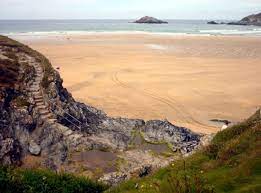The Cornish coast is full of legends of ancient saints arriving in a variety of unusual vessels to set up hermitages and convert the locals to Christianity. Historians believe that there was an influx of Celtic missionaries from Ireland, Wales and Brittany in the fifth and sixth centuries when the area was under threat from pagan Anglo-Saxon invaders. St Piran arrived on a millstone from Ireland, landing on Perran Sands and subsequently becoming Cornwall's most famous saint.
Here in Crantock, the saint was Carantoc, who is said to have arrived on an altar in the sixth century. Like St Piran, he built an oratory, a simple chapel near a well. The 'Round Orchard' in the centre of Crantock village is thought to be the site of this chapel, and in the centre of the village, there is a seventeenth-century well, known as St Carantoc's Well. The stained glass windows in the parish church of St Carantoc depict St Carantoc's life story. The church is Norman, although it was restored at the start of the twentieth century.


There was another saint here in medieval days, St Ambrose, also known as St Ambrusca.
His chapel was first recorded in 1309 when Bishop Lacy granted 40 days indulgence to all pilgrims visiting the chapel. Although the chapel ruins were still visible in the churchyard in the eighteenth century, there is no sign of them today. However, St Ambrusca's Well can be seen beside Beach Road, with a modern door depicting the Celtic saint.
Penpol Creek ('penpol' in Cornish means 'head of the creek'), is an inlet off the River Gannel. It was once known as the Port of Truro, and goods landed here were taken by cart or packhorse up the track to Trevemper, an important commercial centre three miles upstream. At low tide, you can still see the quays, steps, mooring rings and chains along the wooded western shoreline of Penpol Creek. Other vessels brought their cargoes into Fern Pit, across the water from Penpol, and this was then transferred to shallow-draught barges to be carried on the flood tide up to Trevemper, at the tidal limit of the river, where there is still a packhorse bridge today.
Until as late as the end of the nineteenth century the Gannel was used extensively by shipping. Iron ore from the Great Perran Iron Lode was brought here to be shipped to Wales, and Welsh coal was brought back for the Truro smelting works. There was also a lead and silver smelting works on this bank of the river. A lime kiln at Penpol is still visible today, where coal and limestone were burnt together to make lime, used mainly as a fertiliser.

Although you wouldn't believe it to look at the dunes today, this was once the site of the Lost City of Langarrow, buried by a sandstorm over 900 years ago. It is claimed to have been the largest city of its type in England. It had no fewer than seven churches, each with its own churchyard. Archaeologists have found extensive burial sites throughout the area, dating right back to prehistoric times, and human remains have been found in many of Crantock's cottage gardens.
Langarrow was a land of plenty, with large tracts of richly productive agricultural land, mines yielding an abundance of tin and lead and a sea said to be overflowing with many different kinds of fish. Convicted criminals were brought here from all over the country to work in the fields and mines. They dredged the sand from the Gannel and built a harbour at its mouth. They lived in rough huts on the moorland outside the city and their principal food was the cockles and mussels they gathered from the shore.
The landowners here, according to the legends, lived a life of luxury which soon turned to sin, calling down the wrath of God. A savage storm blew up, lasting for three days and three nights. The sand dunes from Crantock to Perran were formed. They wiped the city of sin from the face of the earth.



